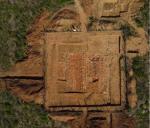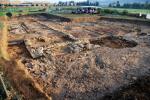Summary (English)
The 2013 excavations foresaw the continuation of work inside the fenced-in area and the digging of four sondages in the immediately surrounding area aimed towards gaining a better understanding of the overall topography of the archaeological site.
Three sondages were dug in the field immediately east of the enclosed area, aligned with the via glareata that skirted the construction to the south, in order to see whether the road continued. The presence of the road was checked to a distance of c. 15 m from the fence.
There were no traces of the road in the next sondages, but substantial remains of what appeared to be the enclosing wall of a productive structure were revealed, perhaps a tile kiln. Given the explorative nature of the trenches, it was decided to wait until the next campaign before undertaking a detailed excavation of the productive complex, which appears to be of great interest for the study of settlement transformation on the site.
Another sondage, put in on the same alignment about 40 m further east confirmed the absence of traces of paved road surface. This means that further thinking is necessary regarding the way in which the structures found to date were linked to the road network connected to the Via Aurelia/Aemilia Scauri, the line of which remains unknown in this area.
A fourth and larger sondages (c. 5 × 5 m), was dug immediately west of the enclosed area, in line with the south wing of the porticoed courtyard of the mansio. The aim of this trench was to check the development in this area of the structures of the courtyard entrance. The courtyard lies within the enclosed area and is in the course of excavation.What the trench revealed was unexpected: the ancient and late antique stratigraphy was heavily damaged by modern interventions, but what remained presented alignments and levels that did not correspond exactly to what had been expected based on the remains investigated in the adjacent area. The trench was completely flooded following heavy rain and so excavations were limited to what was strictly necessary for the documentation of what had been exposed. More extensive excavation will be undertaken in a future campaign.
Inside the enclosed area, excavation concentrated on the structures of the southern entrance to the mansio. Here, a corridor paved in opus signinum was completely exposed. Excavations also took place in the south-eastern corner of the porticoed courtyard.
In the latter sector, there was evidence showing that a work area had been set up in the late antique period probably for the recovery and melting down of metal taken from the villa/_mansio_ and for glass production, as suggested by the presence of glass slag.
- Enrico Zanini - Università di Siena, Dipartimento di Archeologia e Storia delle Arti
Director
Team
- Elsa Pacciani - Ministero per i Beni e le Attività Culturali
- Andrea Camilli - Soprintendenza per i Beni Archeologici della Toscana
- Samanta Mariotti - Università degli Studi di Siena
- Elisabetta Giorgi - Università degli Studi di Siena
- Alessandro Carabia - Università degli Studi di Siena
- Pasquino Pallecchi
- Francesco Ripanti - Università degli Studi di Siena
- Nina Marotta - Università degli Studi di Siena
Research Body
- Università degli Studi di Siena
Funding Body
- Azienda Agricola Tenuta di Vignale s.r.l.
- Azienda Agricola “La Traiana”, Poggionuovo Bracciolini (AR)
- Camping Pappasole s.r.l.
- Comune di Piombino - Quartiere di Riotorto
- Direzione Nazionale Unicoop Tirreno






![Download [PDF]](/excavation/skins/fasti/images/results/download_sml.png)

